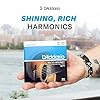Tyramine, a naturally occurring compound found in various aged and fermented foods, can trigger headaches in susceptible individuals.
These “tyramine headaches” can range from mild discomfort to severe migraines, including migraines with aura.
Many foods containing tyramine, such as smoked turkey, aged cheeses, and certain wines, are often part of a Thanksgiving dinner, making this an especially relevant topic during the holiday season.
What is Tyramine?
Tyramine is a byproduct of the amino acid tyrosine formed during food aging or fermentation.
It is found in high concentrations in certain foods and beverages, mainly aged, cured, smoked, or fermented.
Mechanism of Headache Induction: Tyramine can affect blood pressure by releasing norepinephrine, a neurotransmitter.
In sensitive individuals, this can lead to vasoconstriction or vasodilation, triggering headaches or migraines.
Foods That Can Cause Tyramine Headaches
Common Tyramine-Rich Foods:
- Processed Meats:
- Ham
- Smoked turkey
- Salami
- Sausages
- Dairy Products:
- Aged cheeses (e.g., cheddar, blue cheese, Swiss)
- Parmesan
- Legumes and Nuts:
- Peanuts
- Soy products (e.g., soy sauce, miso, tofu)
- Fermented and Pickled Items:
- Sauerkraut
- Kimchi
- Pickles
- Alcoholic Beverages:
- Red wine
- Beer (especially craft and dark beers)
- Other Culprits:
- Overripe bananas
- Avocados
- Chocolate
Note: The concentration of tyramine in these foods can vary depending on individual sensitivity, food processing, storage, and preparation methods.
Symptoms of Tyramine Headaches
Tyramine headaches can manifest differently depending on the individual’s sensitivity and the amount of tyramine consumed.
Symptoms can range from mild to severe. Typically, the amount of aura coincides with the severity of the headache.
- Mild Headache:
- A dull, persistent ache in the temples or forehead.
- Often mistaken for tension headaches.
- Moderate Headache:
- Throbbing pain, often localized to one side of the head.
- Nausea and light sensitivity may accompany the pain.
- Migraine with Aura:
- Severe headaches often precede or coexist with visual disturbances (e.g., light flashes and blind spots).
- Symptoms may include dizziness, nausea, vomiting, and sensitivity to light and sound.
Samples of Aura During Migraine
The image below shows the distortion of the left visual field. Note that the grass and trees become blurred.

Another example is the zigzag distortion of the tip of the arch below. Note that the distortion remains in the same location whenever the head is turned.

The negative scotoma or blurring of vision in a small location in the field of vision may happen while reading or looking at a computer monitor.

Tyramine Prophylaxis
Preventing tyramine headaches involves not only dietary management but also proactive supplementation.
A promising approach is supported by the findings of the study by Visser et al. in 2020.
Antioxidant Prophylaxis Strategy:
A combination of vitamin C, E, and N-acetylcysteine (NAC) has significantly reduced headache and migraine frequency.
The recommended regimen from the study includes:
- Vitamin C: 500 mg
- Vitamin E: 167.5 mg (250 IU)
- NAC: 600 mg
- Dosage: Taken twice daily for three months.
Study Outcomes:
Participants who adhered to this antioxidant combination experienced a significant decrease in monthly headache and migraine frequency compared to the placebo group.
This suggests that the synergistic effects of these antioxidants not only mitigate oxidative stress but also stabilize vascular and neuronal health, reducing sensitivity to tyramine triggers.
Implementation for Tyramine Headache Prevention:
- Begin the prophylactic regimen if tyramine sensitivity is suspected or confirmed.
- Maintain consistent use for three months to evaluate effectiveness.
- Pair with dietary adjustments, avoiding high-tyramine foods such as aged cheeses, processed meats, and fermented beverages.
Incorporating this evidence-based prophylactic strategy may help those prone to tyramine headaches enjoy more excellent relief and fewer disruptions to their daily lives.
Treating Tyramine Headaches
If tyramine headaches occur, some effective treatments involve the following options:
- Primary Treatments:
- N-acetylcysteine (NAC): NAC is a potent antioxidant that supports liver detoxification, helping the body metabolize tyramine more effectively. It may reduce headache severity and duration.
- Suggested dose: 600–1200 mg per day.
- Mechanism: Neutralizes free radicals and supports glutathione production to reduce inflammation.
- NAC has many uses, so I buy a lot. BulkSupplements.com NAC Powder – N-Acetyl Cysteine 600mg, NAC Supplement
- Vitamin C: Vitamin C is another antioxidant that can mitigate the effects of tyramine by reducing oxidative stress and stabilizing blood vessels.
- Suggested dose: 500–1000 mg per day.
- N-acetylcysteine (NAC): NAC is a potent antioxidant that supports liver detoxification, helping the body metabolize tyramine more effectively. It may reduce headache severity and duration.
- Other Treatments:
- Hydration: Drinking water can alleviate mild headaches and help flush tyramine from the system.
- Over-the-Counter Pain Relievers:
- Acetaminophen or ibuprofen for temporary relief.
- Magnesium Supplements: Magnesium can help stabilize blood vessels and reduce headache frequency.
- Preventive Measures:
- Keep a food diary to identify specific triggers.
- Avoid large meals of tyramine-rich foods, especially in the evening.
- Consult a healthcare provider for additional guidance.
Conclusion
Tyramine headaches can be a significant issue for many individuals, especially those prone to migraines. By understanding the foods that contribute to tyramine accumulation and adopting effective treatments like NAC and vitamin C, it is possible to manage and reduce the frequency and severity of these headaches.
Additionally, incorporating an evidence-based prophylactic regimen, such as the combination of vitamin C (500 mg), vitamin E (167.5 mg or 250 IU), and NAC (600 mg) taken twice daily for three months, has been shown to significantly decrease monthly headache and migraine frequency.
This proactive approach and dietary adjustments offer a comprehensive strategy for preventing and managing tyramine-induced headaches.
If you suspect tyramine sensitivity, consider working with a healthcare provider to develop a personalized prevention and treatment plan.
Personal note:
I can personally vouch for the effectiveness of NAC plus Vitamin C in preventing and treating tyramine headaches. After taking them, the symptoms start to resolve in minutes.
Don’t Get Sick!
Stay current by subscribing. Feel free to share and like.
If you find value in this website, please consider buying a coffee or two or five to show your support.
- Foods High in Tyramine
- How Can Foods Cause Migraine and Hypertension?
- Can Healthy Foods Give You Migraine and Hypertension?
- Foods That Can Cause Monoamine Oxidase Inhibition
- Migraine Aura Without Headache
NAC articles
- Many Nuclear Emergency Meds From the WHO Are OTC
- 12 Powerful Antioxidants to Safeguard Your Body from Harmful Ionizing Radiation
- 11 Best Morning Supplements For Energy
- How to dose Nattokinase, Bromelain and NAC
- 6 Potential Uses of the Bismuth + NAC combination
- Colloidal bismuth and NAC inhibit SARS-CoV-2 replication
- N-Acetylcysteine (NAC) for COVID-19
References
- Fayed et al. The correlation between the frequent intake of dietary migraine triggers and increased clinical features of migraine (analytical cross-sectional study from Egypt). Sci Rep 14, 4150 (2024).
- Visser EJ et al. Reduction in Migraine and Headache Frequency and Intensity With Combined Antioxidant Prophylaxis (N-acetylcysteine, Vitamin E, and Vitamin C): A Randomized Sham-Controlled Pilot Study. Pain Pract. 2020 Sep;20(7):737-747.
- Panconesi, A. Alcohol and migraine: trigger factor, consumption, mechanisms. A review. J Headache Pain 9, 19–27 (2008).
Image credits:
- Scintillating scotoma-By Mikael Häggström, used with permission. – Own work Original photo without aura. CC0, https://commons.wikimedia.org/w/index.php?curid=15571417
- Zigzag distortion By S. Jähnichen (talk) – File:Brandenburger_Tor_Blaue_Stunde.jpg, CC BY-SA 3.0, https://commons.wikimedia.org/w/index.php?curid=6668865
- Negative scotoma-By S. Jähnichen – File:Brandenburger_Tor_Blaue_Stunde.jpg, CC BY-SA 3.0, https://commons.wikimedia.org/w/index.php?curid=6668898
© 2018 – 2024 Asclepiades Medicine, LLC. All Rights Reserved
DrJesseSantiano.com does not provide medical advice, diagnosis, or treatment
As an Amazon Associate, I earn from qualifying purchases.
MedPride Powder-Free Nitrile Exam Gloves, Iris Blue, Medium, Box/100
2% Off3-Pack 8" Heavy Duty Scissors with Ultra Sharp Blades and Comfort Grip Handles - For Office, Home, School, Sewing, and Crafts
20% OffHe Who Fights with Monsters 12: A LitRPG Adventure: He Who Fights with Monsters, Book 12
12% OffOneOdio Wired Over Ear Headphones Hi-Res Studio Monitor & Mixing DJ Stereo Headsets with 50mm Drivers and 1/4 to 3.5mm Jack for AMP Computer Recording Podcast Keyboard Guitar Laptop - Black
17% OffD'Addario Acoustic Guitar Strings - 80/20 Bronze - For 6 String Guitars - Deep, Bright, Projecting Tone - EJ11 - Light, 12-53
36% OffDiscover more from Don't Get Sick!
Subscribe to get the latest posts sent to your email.























